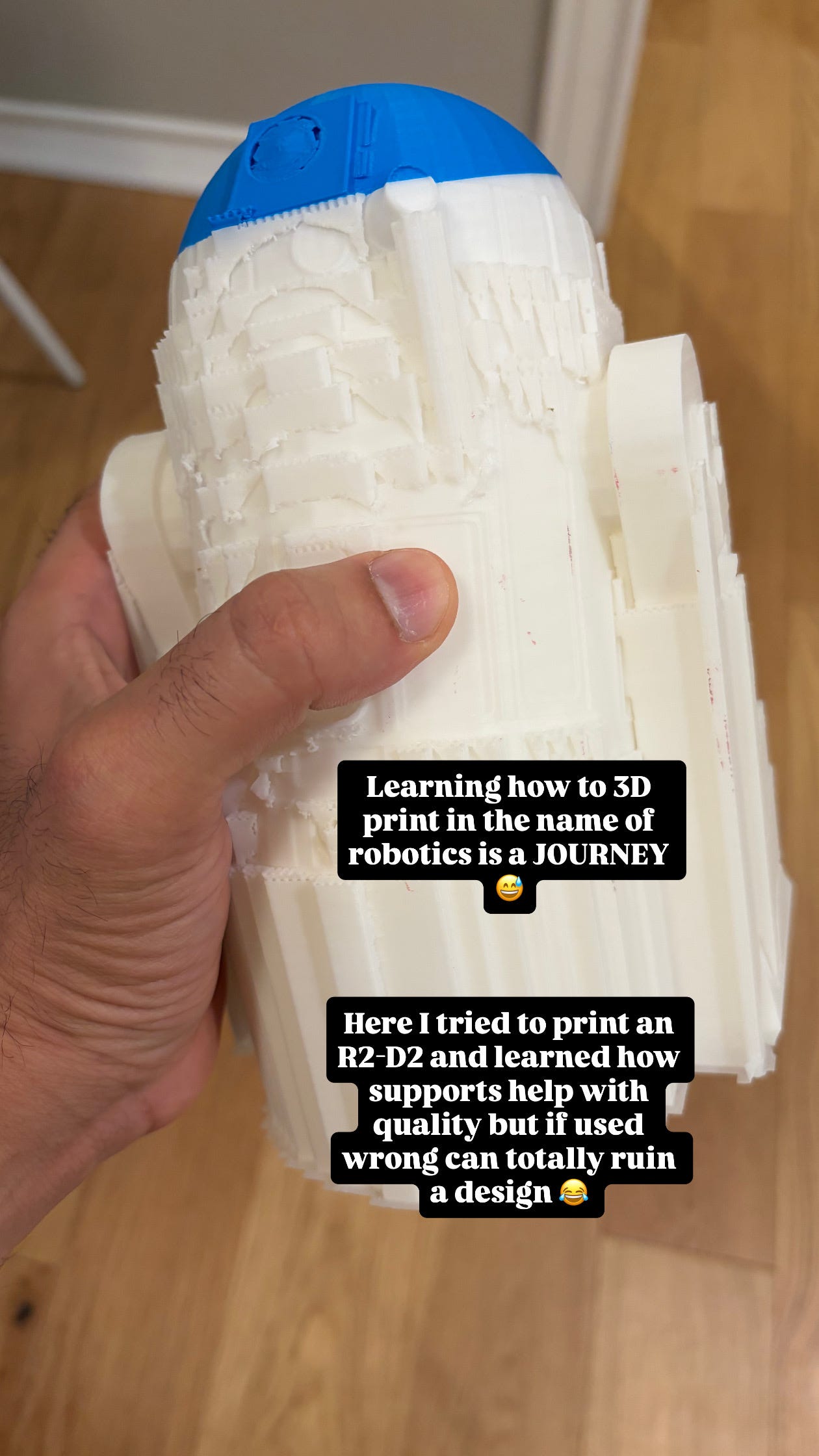Hope you enjoy this episode!
As an aged father of little ones, I can’t write AND podcast at the same time. My sleep-deprived brain just can’t handle it.
So yes, the written version below is, in fact, AI generated based on what I discuss on the pod. Thus, the best experience I think is the audio, but in case you can’t experience that, a written version is below.
Let me know if you enjoy it by subscribing below, I hope you do! See you next week…
Welcome to week 47 of the Millennial Product Manager podcast—I think that’s what we’re calling it now.
I am back down here in my dungeon. The 3D printer is going here in the kids’ playroom, and we are preparing for Thanksgiving. It’s going to be great. I won’t be doing a pod next week, obviously; I think everybody’s going to be in their food coma, drinking, watching football, and hanging out with loved ones.
I grew up in Dallas, so I’m taking the whole family back there. We get to watch the Texas game, and... I’m worried. As a Longhorn alum, I am worried. But we’ll see how this week goes.
It has been a big, eventful week. Let’s get into it.
Gemini 3.0 and the Platform Advantage
The first thing I wanted to talk about is obviously the huge release from Google this week with Gemini 3.0. I’ve been using it, of course. It’s impressive. The “pro” part—the thinking part—is a bit annoying; hopefully, they release a version of Gemini 3.0 Fast that I can use for day-to-day stuff.
But what is happening as a result of this release is that I’m really reconsidering my tech stack here. I used to think I was going to be a ChatGPT user going forward, and that was just the platform I was going to use. But honestly, the Gemini 3.0 release has really got me thinking.
This, combined with the news that Apple is likely going to use Gemini for their Siri implementation in March, highlights something important. When you use something like Google or your Apple products—your iPhone, iPad, MacBook—those offerings have a robust platform that comes with the AI solution.
It’s not just about Gemini. It’s not going to be just about whatever Siri looks like in March. It’s the fact that all that stuff works well with Gemini.
One of the things I’ve noticed is that Gemini can search all of my Gmail. I can ask questions about Gmail. It works natively. It can pull stuff from my calendar. It works with Google Search, which is obviously a powerhouse and incredibly accurate. They’re not building stuff from scratch. When I use Siri, it works with my Apple Reminders, Notes, and Mail. It has all of my previous account history in both places.
I think going forward, the winners in the AI space are going to be the ones that couple AI with their platform advantage.
It’s not just about the models. The models are great—having a frontier model is important—but it’s everything around that experience. It’s the full offering that gives something like Gemini an advantage.
Don’t discount the platform investment. Don’t discount the platform experience that you’re going to offer along with the AI experience. What we’re finding is that AI by itself is not enough.
The Struggle to Find Value in Software
If you work in tech, or if you work the kind of job that I do as a product manager, there’s always this itch to be entrepreneurial and do something on your own.
But one of the things I’ve noticed is that I’m really struggling with what I would want to invest in on the side, or as a little startup in software. I actually am struggling with just what is even valuable anymore.
Like we were talking about earlier: Platform plus AI is really valuable. It’s not enough to go build an AI-based chat experience for X, Y, Z thing. That’s not enough. I’m finding I’m having a hard time thinking of things to make that leverage AI but are valuable without the platform investment that’s required. And creating platforms is hard. Creating marketplaces is hard. It’s a lot of grind.
It changes every hour. What’s actually valuable? What’s actually useful? Whole startups are getting destroyed, whole companies are getting destroyed overnight.
There’s a big rush, and people are taking chances trying to figure out what’s going to be worth it, but man, it’s really difficult to figure out what to invest in on the software side right now.
Elon Musk and the Sunk Cost Fallacy
I came across this video of Elon Musk talking about the five key things he’s learned building things, standing in front of a rocket. I think a lot of us have seen this video.
One of the things he talks about is how often engineers and technical people don’t ask the question of if the thing that they’re working on is the right thing to be working on. They’re so heads down and focused on optimizing the thing that exists already, that they don’t stop and ask the question: Why? Why does this product exist? Why does this experience exist? Why should it continue to exist?
I’ve actually been running into that a lot lately.
Coming back to the point about how AI is totally changing the game on what’s valuable in software—there are things that I have built, or that have been built as part of my job, that I actually doubt are valuable anymore. I doubt they should continue to exist in this new world that we’re all living in.
But I’m finding that it is actually difficult to get people to move on from these implementations. Even things that were built six months ago or a year ago. It reminds me of that point Elon is making: sometimes due to sunk cost fallacy, it’s hard to walk away.
In this world we’re living in with AI, you have to ask that question more and more. Just because a system exists doesn’t mean we shouldn’t build something completely new.
Link to video:
The Steep Learning Curve of Robotics
Finally, as you know, I’ve been on this robotics adventure. You can probably hear the 3D printer going in the background.
The learning curve for robotics is steep, and that includes things like 3D printing. It’s taken me a lot of test prints to figure out how to properly print things. If you follow me here on Substack or on Instagram, you’ve probably seen some of the examples, like R2-D2.
I printed a large version of him with a ton of supports, but the problem was those supports were just glued onto him. I couldn’t get them off. It was impossible.
Then I learned how to use tree supports, and that’s gone a lot better, but I still have to learn how to remove them properly.
Then I had to transition software. The Creality printer I have comes with a default software that was just messing everything up. So I had to switch to Orca Slicer and get that dialed in—learning from TikTok and YouTube how to properly print things on Orca Slicer.
Now I’m messing with this Jetson Orin Nano board from NVIDIA, and I’m back in the engineering days of flashing firmware, loading stuff via an SD card, and installing an SSD to expand memory so it can handle real-time models and computing at the edge.
It is just a lot to learn.
Honestly, though, it’s probably the most fun I’ve had with technology in a good while. The more time I spend with it, the more I’m like, “Oh yeah, this is fun.” It’s hardcore engineering stuff that I learned in school. It fulfills a need, especially given the flux I’m feeling in the software world regarding what is valuable to build.
It is steep. It is not for the faint of heart. But few things that are worth doing are easy.
Something you think about when you’re 41 is that you think you’re done learning—that you’ve learned everything you can and you can’t learn quickly anymore. It turns out you’ve still got a pretty good motor. I definitely feel that way as part of this journey. It’s challenging when you have kids and your schedule looks different, but man, is it fun.
That’s it for this week. Thanksgiving is around the corner. Today, it felt like collectively everybody at the company just said, “Alright, Thanksgiving is almost here, let’s give up,” and canceled a bunch of meetings. I think that’s great. We’ve all worked really hard.
Happy Thanksgiving, everyone. Hope you enjoy the break, and we’ll see you when we get back.
Cheers!








